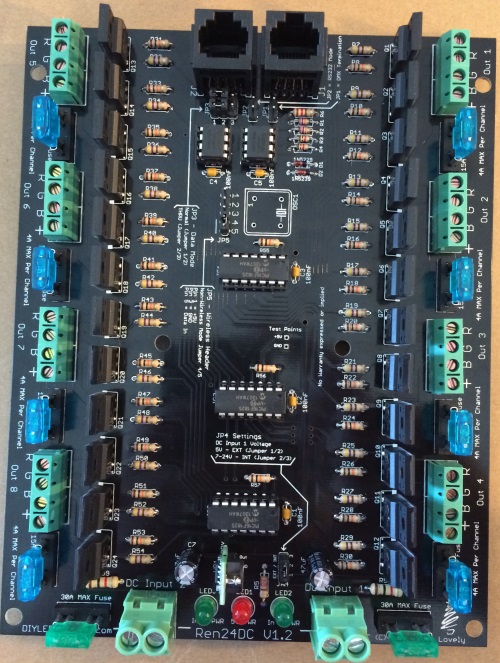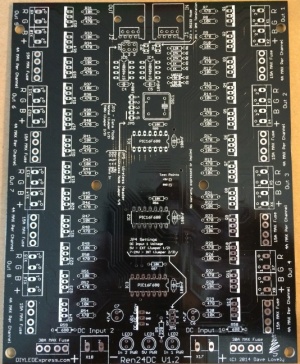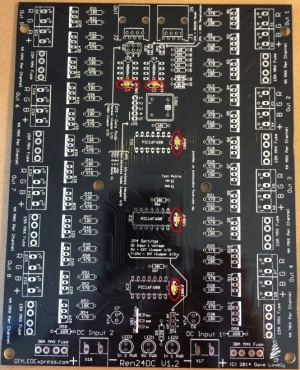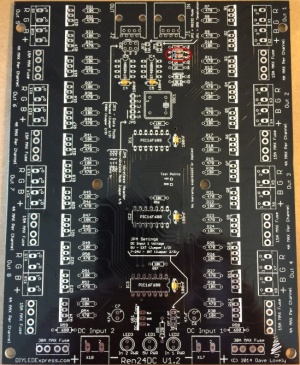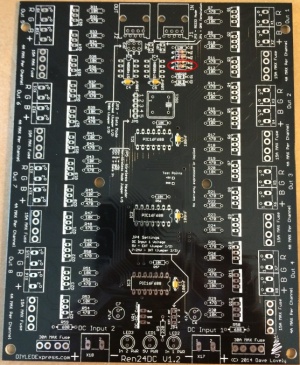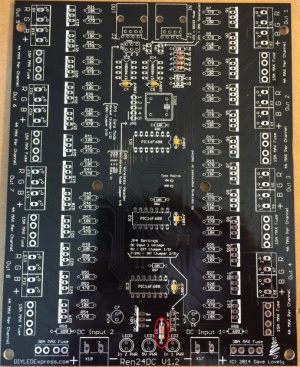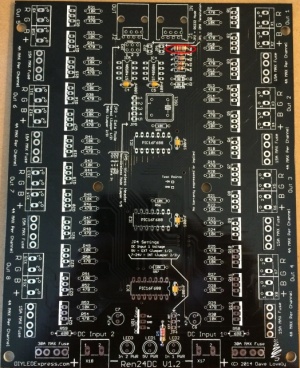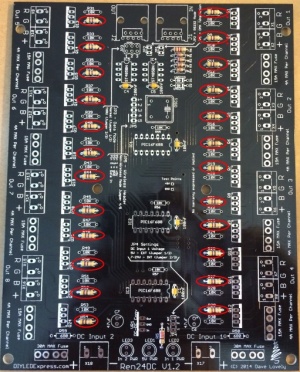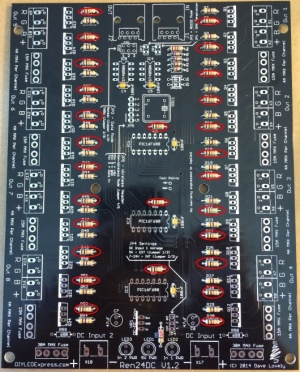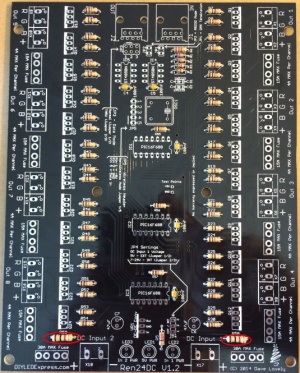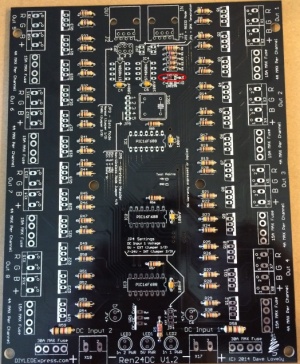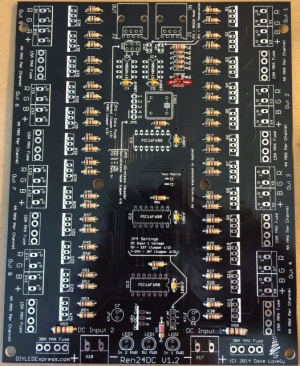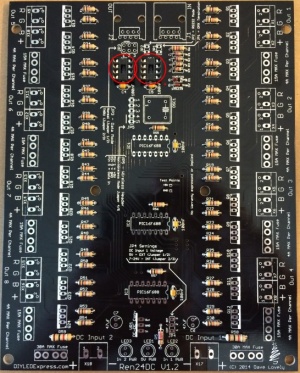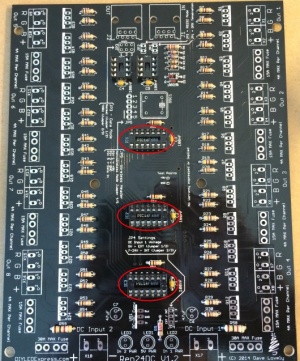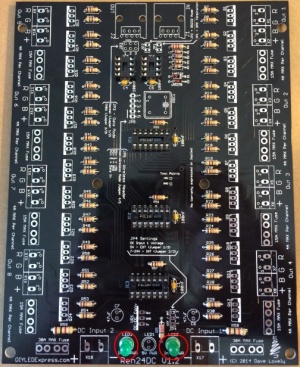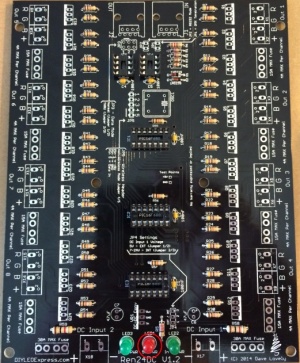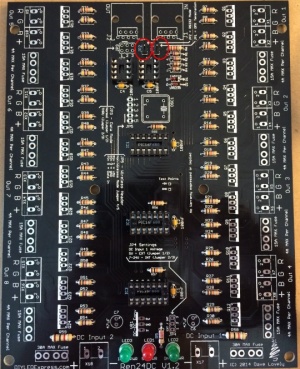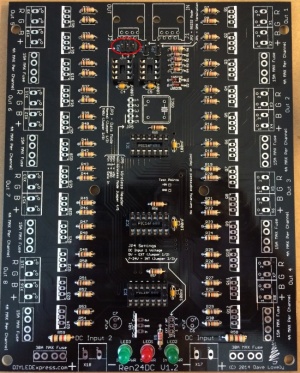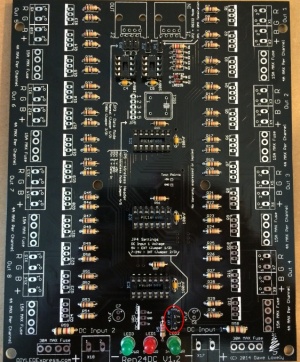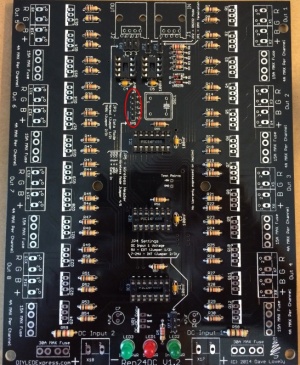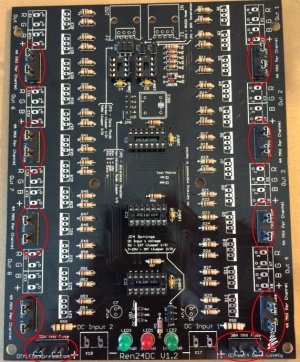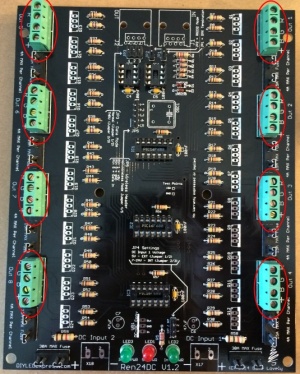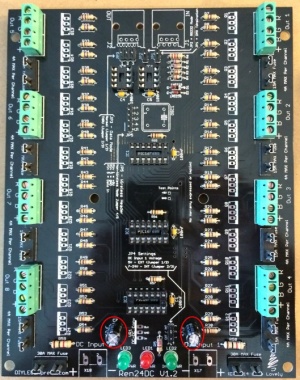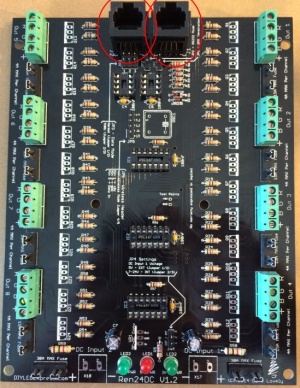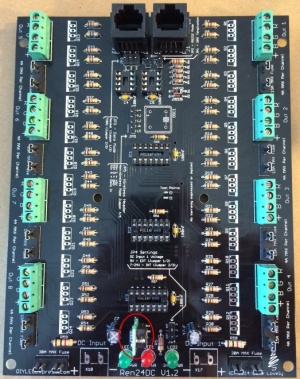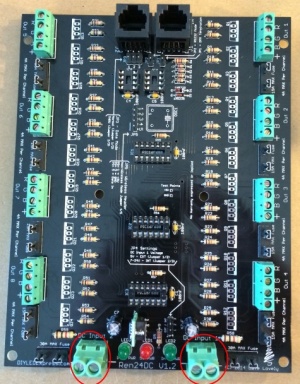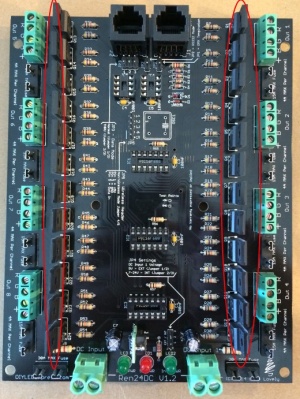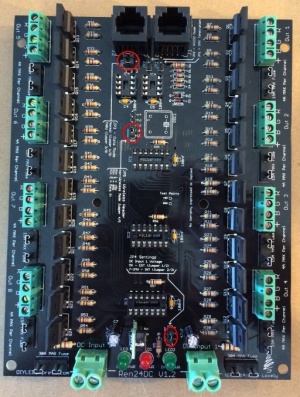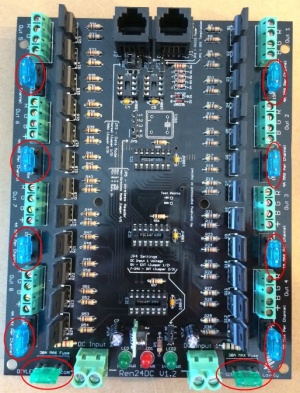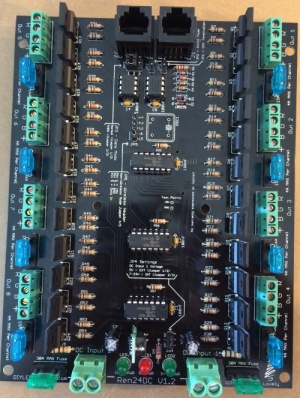Ren24DC
Disclaimers
The standard disclaimers pertaining to the information contained on this wiki page are listed here.
THIS WIKI PAGE IS NOT COMPLETE YET AND HAS NOT BEEN CHECKED FOR ERRORS.
Ren24DC Construction Manual
What is the Ren24DC?
Revision History
Note: Earlier versions of the Ren24DC need to be modified if they are to be used in a daisy chain fashion. For more information please see this thread.
Ren24DC Parts
To build the Ren24DC, you need 4 things:
- The PCB
- The parts to solder on the board, also known as a BOM (Bill Of Materials).
- A power supply to power the board. The board can use any 5-24VDC power supply.
- An enclosure to mount the finished board in. Commonly used enclosures include the CG-500, CG-1000 or the CG-2000 which are available from several vendors
The BOM parts needed to build the board are:
| Mouser BOM | |||
| Part ID | Mouser PN | Description | Qty |
| R1 | # | Resistor | 3 |
You can buy the parts directly from Mouser: Click here for Mouser Direct Project BOM
or
The BOM is also available at a discount in a kit that includes the PCB from DIYLEDExpress.com
Building the Ren24DC
The Ren24DC requires a fair bit of soldering so take your time and ensure you install the components in the correct orientation when required. Start by sorting the components by type and values. Look over the PCB before starting noting the location of the various components. Follow the standard procedure of installing the lowest profile parts first and ending up with the tallest. You can click on any photo to see a larger version of the image.
- □ - Begin by inspecting the PCBs to look for any defects such as cracks or breaks. The holes on the board should be open on both sides. Then inspect and sort out the various parts for the boards.
- □ - Install the five 0.1uF (100nF) capacitors C1-C5. The capacitors are not polarized and can be mounted either way.
- □ - Install the two 27K Ohm resistors (red, violet, orange, gold) R1,R2 The resistors are not polarized and can be mounted either way.
- □ - Install the two 1K Ohm resistors (brown, black, red, gold) R3,R4 The resistors are not polarized and can be mounted either way.
- □ - Install the one 220 Ohm resistors (red, red, brown, gold) R5 The resistors are not polarized and can be mounted either way.
- □ - Install the one 120 Ohm resistor (brown, red, brown, gold) R6 The resistors are not polarized and can be mounted either way.
- □ - Install the twenty-four 470 Ohm resistors (yellow, violet, brown, gold) R7,R9,R12,R13,R15,R17,R19,R21,R23,R25,R27,R29,R30,R32,R34,R36,R38,R40,R42,R44,R46,R48,R50,R52,R54 The resistors are not polarized and can be mounted either way.
- □ - Install the twenty-seven 10K Ohm resistors (brown, black, orange, gold) R8,R10,R12,R14,R16,R18,R20,R22,R24,R26,R28,R30,R31,R33,R35,R37,R39,R41,R43,R45,R47,R49,R51,R53,R55,R56,R57 The resistors are not polarized and can be mounted either way.
- □ - Install the two 2.2K Ohm resistors (red, red, red, gold) R58,R59 The resistors are not polarized and can be mounted either way. NOTE: The silkscreen says 680 but the BOM supplies a 2.2K Ohm resistor to work with the full range voltages the board supports. If you use a 680 Ohm resistor keep the voltage under 12V!
- □ - Install zener diode D1 (1N5229B). The diode must be installed correctly. The diode should have a black stripe on the orange/red body. Make sure that this stripe lines up with the stripe on the PCB silkscreen (to the left).
- □ - Install zener diode D2 (1N5239B). The diode must be installed correctly. The diode should have a black stripe on the orange/red body. Make sure that this stripe lines up with the stripe on the PCB silkscreen (to the left).
- □ - Install two 8-pin IC sockets for IC4,IC5. Install with the notch to the top.
- □ - Install three 14-pin IC sockets for IC1,IC2,IC3. Install with the notch to the right.
- □ - (OPTIONAL!! Not needed for the PIC16F1825) Install the clock oscillator OSC1. The oscillator must be installed in the correct orientation. The oscillator has three rounded corners and one squared corner, make sure that the squared corner is positioned to match the PCB silkscreen (upper left corner).
- □ - Install two green LED LED2,LED3. The LEDs are polarized and must be installed correctly. The short lead is the cathode and must be placed in the square solder pad.
- □ - Install one red LED LED1. The LED is polarized and must be installed correctly. The short lead is the cathode and must be placed in the square solder pad.
- □ - Install two 2-pin vertical headers JP1,JP2. Install the short end through the board. These headers have no polarity to worry about.
- □ - Install one dual row 3-pin vertical header JP3. Install the short end through the board. These headers have no polarity to worry about.
- □ - Install one 3-pin vertical header JP4. Install the short end through the board. These headers have no polarity to worry about.
- □ - Install one 5-pin vertical header JP5. Install the short end through the board. These headers have no polarity to worry about.
- □ - Install ten fuse clips. The fuse clips have no polarity to worry about.
- □ - Install eight terminal blocks sets for RGB outputs. Install with the openings for the wires facing off the edge of the board.
- □ - Install two 47uF capacitors C6,C7. This capacitor is polarized and must be installed correctly. The capacitor should have a silver/grey stripe on the body to indicate which lead is negative. The positive lead of the capacitor will be the longer lead. Make sure that the positive lead is placed in the pad with the +.
- □ - Install two RJ45 modular jacks J1,J2. Due to minor variations in manufacturing, some RJ45 jacks are a tighter fit than others. Care should be taken to ensure that the pins are aligned first before applying too much pressure to seat the locking lugs through the board.
- □ - Install the DC-DC Converter VR1. The voltage regulator is polarized and must only be installed one way. The flat side of the voltage regulator must be mounted towards the left side of the board, aligning with the stripe on the pcb.
- □ - Install two large terminal blocks for the inputs. Install with the openings for the wires facing off the edge of the board.
- □ - Install the twenty-four MOSFETs. The MOSFETs are polarized and they should be installed with the tab facing the screw terminals.
- □ - Install the four required jumpers. Default settings are: JP3 - Two jumpers shorting 1/2. JP4 - Make selection on Voltage used. JP5 - Jumper pins 4/5.
- □ - Install the eight 15A and two 30A Fuses. The Two Green 30A Fuses are installed at the bottom of the board.
- □ - Congratulations! That completes the construction of the Ren24DC!
Jumpers
JP1 - DMX Termination
Install shunt to terminate DMX input
JP2 - RS232 Mode
Install shunt for RS232 input
JP3 - Data Mode
Normal Operation Jumper Pins 1/2 on both rows
Thru Operation Jumper Pins 2/3 on both rows
JP4 - Power Jumper
This jumper is used if you are supplying either a well regulated +5v or unregulated +7-24v. If you apply +5vdc to the terminal block, you should put the jumper on the "EXT" setting (indicating you are getting 5v externally). If you apply +7-24vdc, you should put the jumper on the "INT" setting (indicating you are getting 5v internally via the 5v regulator).
You MUST ensure you have this jumper set correctly if you are using voltages greater than 5v as it may (and probably will) cause permanent damage to some components on the board.
JP5 - Wireless Header
Install shunt on pins 4/5 for normal operation.
Pin 1 - +5V
Pin 2 - No Connection
Pin 3 - GND
Pin 4 - Data From RS485
Pin 5 - Data To PIC
Powering the Ren24DC
Initial Testing
TroubleShooting
So - you've built your new Ren24DC, connected it up to your computer and tried a quick sequence and nothing happens! There are several checks to perform in order:
Visual Inspection
The very first step involves a close visual inspection of the board. Double check that you have the correct component in the correct location and in the correct orientation. Look at every single solder connection and if some are not shiny or look suspect - reflow them to be sure.
Power
Measure the voltage supplied to the Ren24DC and ensure it's either +5vdc or +7-24vdc and ensure the power jumper is set correctly. Measure the voltage with the supply plugged in and connected to the Ren24DC to ensure it's not shorting out. If the voltage is correct then you know the input level is correct.
Remove any/all socketed chips from the board before proceeding.
FAQ
TBD
